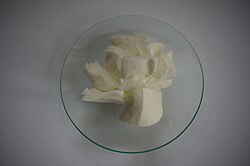Nitrocellulose
Nitrocellulose (also: cellulose nitrate, flash paper) catches fire quickly. It is formed by nitrating cellulose through exposure to nitric acid or another powerful nitrating agent. When used as a propellant or low-order explosive, it is also known as guncotton. Nitrocellulose can be plasticized by camphor. Kodak, and other suppliers, used placticized nitrocellulose as a film base in photograph, X-ray films and motion picture films. People call this nitrate film. After numerous fires caused by unstable nitrate films, safety film started to be used from the 1930s in the case of X-ray stock and from 1948 for motion picture film.
| Nitrocellulose[1] | |
|---|---|

| |
| Other names | Cellulose nitrate; Flash paper; Flash cotton; Flash string; Gun cotton; Collodion; Pyroxylin |
| Identifiers | |
| CAS number | |
| Properties | |
| Molecular formula | (C6H9(NO2)O5)n (C6H8(NO2)2O5)n (C6H7(NO2)3O5)n |
| Appearance | Yellowish white cotton-like filaments |
| Melting point |
160 to 170 °C, Expression error: Unrecognized word "to". K, Expression error: Unrecognized word "to". °F |
| Hazards | |
| NFPA 704 |
|
| Except where noted otherwise, data are given for materials in their standard state (at 25 °C, 100 kPa) | |
Nitrocellulose Media
Table tennis ball, prepared from nitrocellulose (Celluloid)
Deflagration test of nitrocellulose in slow motion
Jam tin grenades were made in World War I using gun cotton
Lubin film vault custodian Stanley Lowry (foreground) surveys the rubble after fire and explosions, June 1914.
Decayed nitrate film, EYE Film Institute Netherlands
'United States Inter-Agency Committee for Nitrate Film Vault Tests' – film transfer from 1948 about testing storage and flame suppression methods of nitrate film stock; runtime 00:08:41
References
- ↑ Merck Index (11th ed.). p. 8022.








